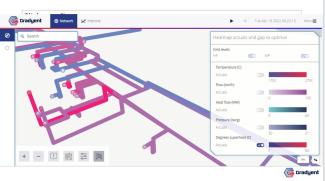Real-time Digital Twin of Steam Grids
End-to-end, real-time monitoring, optimisation and transformation of Steam Grids
With our real-time Digital Twin Platform, we create a digital copy of your complete steam network, running in real-time, combining geospatial, weather, sensor and any other relevant data from your system with physics-based models and AI. It provides insights for your entire network - even for places where you do not have data or metering. This lets you optimise your grid and run simulations of future situations for a more efficient operation. Assure the right steam quality and quantity is available at each point of the steam network, aligned with your production schedules in real-time, simultaneously preventing unnecessary losses. Control cost & carbon emissions. Use the advisory capabilities of our Digital Twin Platform to guide you through your steam system adjustments and run simulations on how your system can meet your needs at the optimal cost.
Our real-time Digital Twin Platform puts you in control with five solutions that matter
1.Temperature, Pressure and Mass Balance
Accurately predict and balance optimal steam temperature and pressure levels across your entire steam network. Use our validated live, dynamic setpoints as often as once a minute, selected from up to ten thousand optimization scenarios each time. All while ensuring stable supply and demand, even under changing demand and weather conditions thanks to our real-time Digital Twin Platform's 48-hour forecast of your complete system's performance. Confidently anticipate demand of operations and supply the right amount of correct steam quality, while dealing with flagged anomalies in the network before they become an issue.
2. Heat Source Scheduling and Control
Optimise your production schedule for heat and electricity (CHP) in real-time during the day and for upcoming days, across all assets and source locations in your network. Also further optimise conventional CHP's (gas, coal, biomass) and boilers or modern sustainable heat sources such as heat pumps, waste heat and buffers within your industrial facility.
3. Steam Usage Control
Get a thorough grip on your steam network and clear insight into all performance parameters, live. Connect, clean and combine all your available usage data with our real-time Digital Twin Platform. Increase reliability and reveal where and when steam quantities and steam quality are not in line with demand. Avoid unnecessary venting. Rely on setpoint and network operations as advised. Carry out active demand response to shave demand peaks and improve overall grid productivity. Unlock the value from your user data to share with key stakeholders.
4. Issue Detection and Predictive Maintenance
Combine and integrate data from various sensors and sources on our Digital Twin Platform to identify complex issues like leakages, steam trap failure and insulation issues in your steam system more quickly. Fix steam balance inaccuracies. Visualise underperforming network sections, grid anomalies and asset performances. Use effective alerts and enable maintenance action and tracking to facilitate your O&M team.
5. Design and Simulation
Inform decision-making and reduce risk around the introduction of low carbon sources like heat pumps and e-boilers, system changes and extensions through analyses and realistic simulations of new design with actual network data. Our real-time Digital Twin Platform is not based on static offline parameters, but on live incoming data, making the models automatically updated and accurate. An added advantage is that by modelling the complete end-to-end system in detail, oversizing of new sources can be avoided and the impact of upgrades to the overall facility as well as potential performance and productivity improvements can be predicted and easily shared with all stakeholders.
| Specification Title | Specification Description |
|---|---|
|
Application area's
|
Real-time modeling of steam network, Steam Balancing, Supply and Demand: optimal forecasting & scheduling of heat sources vs. steam demand; Downtime & maintenance; Design & Simulation; Reporting
|
|
Optimise
|
• Optimise the balance of their steam network to reduce energy losses and improve operations. • Use the most efficient heat sources and take advantage of primary fuel and electricity price spreads to optimise their network.
|
|
Transform
|
• Make sure their energy backbone -– on their ften your steam network - enables the plant’s transition to a low/no carbon future, taking plant layout, operation, and safety into account. • Plan and implement additional decentralized and sustainable heat
|
Reviews
Sign up or log in to your explorer or platform subscription to get access to the reviews written about this technology.
The Technology Readiness Level (TRL) indicates the maturity level of novel technologies. Learn more about the TRL scale used by us.
[9/9]

